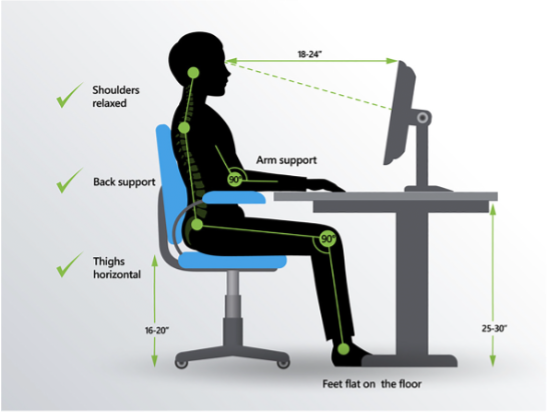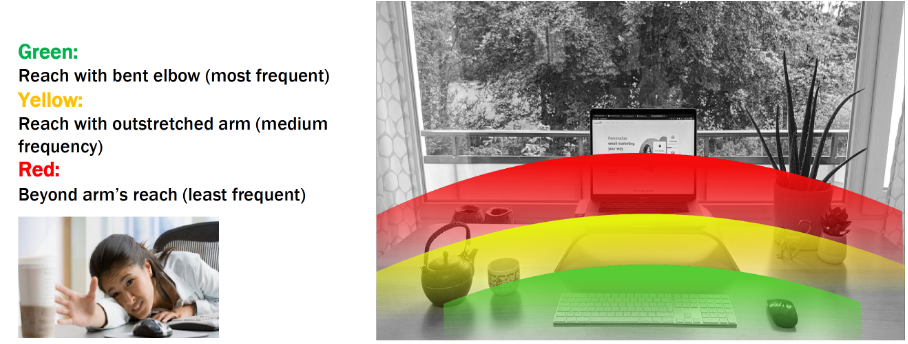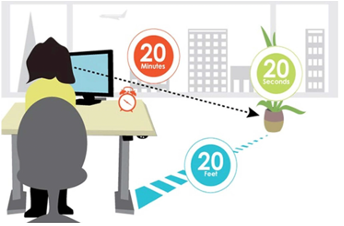WHY IS IT IMPORTANT TO BE HEALTHY AT WORK? WHAT IS ERGONOMICS?
The study of ergonomics focuses on how individuals interact with their surroundings, particularly at work. It entails creating tools, things, and systems that people may use effectively and pleasantly while reducing their risk of harm or pain.
Ergonomics takes into account the physical, cognitive, and social factors that can impact how well a person can perform a task. This includes factors such as body size and shape, strength, and flexibility, as well as environmental factors such as lighting, temperature, and noise levels.
Because repetitive or awkward movements, poor posture, and other variables can lead to musculoskeletal illnesses such carpal tunnel syndrome, tendinitis, and back discomfort, ergonomics is vital. By making jobs easier to complete and more effective, it can also increase productivity and lower the chance of accidents.
Ergonomics principles can be applied in a variety of settings, including offices, factories, and hospitals, to design equipment and work environments that are safe and comfortable for workers. This can involve designing ergonomic furniture, such as adjustable chairs and desks, and organizing workstations and tasks to minimize the risk of injury.
MAINTAIN A NEUTRAL POSTURE AT WORK

Neutral posture is essential at the workplace because it helps reduce muscle fatigue, prevent injury, and improve overall comfort. When you maintain a neutral posture, your body is in a balanced alignment that allows your muscles to work efficiently without being overstretched or strained. This can help reduce the risk of muscle pain, stiffness, and injuries from sitting or standing in awkward positions for long periods. By maintaining neutral posture your general comfort and productivity at work may also be enhanced.
To maintain a neutral posture at the workplace, you should aim to keep your feet flat on the ground, your knees bent at a 90-degree angle, your hips and shoulders relaxed, and your head facing forward. It is also important to avoid sitting or standing in the same position for too long, as this can lead to muscle fatigue and discomfort. Instead, take breaks and stretch periodically to maintain a comfortable and healthy posture.
ARRANGE YOUR WORK DESK USING ERGONOMICS PRINCIPLES.
You should ensure that your workstation is set up ergonomically, with your computer monitor at eye level, your keyboard and mouse at a comfortable height, and your chair adjusted to support a neutral posture.

There are several principles of ergonomics that you can use to arrange your desk at the workplace to promote a comfortable and healthy posture:
- Position your computer monitor at eye level: To prevent you from looking up or down while working and to enable you to gaze straight ahead, the top of the monitor should be at or just below eye level.
- Adjust your chair height: Your chair should be adjusted so that your feet are flat on the ground and your knees are bent at a 90-degree angle when you are sitting. This will help to reduce strain on your legs and back.
- Use a keyboard and mouse that are at a comfortable height: Your keyboard and mouse should be positioned so that your arms are parallel to the ground and your shoulders are relaxed.
- Keep frequently used items within easy reach: Arrange your desk so that items that you frequently use, such as your phone and documents, are within easy reach. This will help to reduce the need to stretch or reach awkwardly while you work.
FOLLOW THE 20-20-20 RULE.
The 20-20-20 rule is a guideline for reducing eye strain and fatigue when working on a computer. The rule suggests that every 20 minutes, you should take a 20-second break and look at something 20 feet (about 6 meters) away. This helps to give your eyes a rest and reduce the strain caused by staring at a screen for long periods.

The 20-20-20 rule is fundamental at the workplace because many jobs involve working on a computer for long periods of time, which can lead to eye strain and fatigue. By following the rule, you can help to reduce these adverse effects and maintain healthy vision. Additionally, regular breaks can help improve your overall productivity and concentration.
TAKE SHORT BREAKS
There are several reasons why short breaks are essential during office hours:
- Improved productivity: By giving your mind a time to rest and recharge, taking brief pauses can assist to enhance your overall productivity. By doing this, you can avoid burnout and return to work with fresh vitality and focus.
- Reduced stress: Taking quick pauses might also help you feel better mentally and lessen tension. In order to relax and clear your thoughts, you need take a little break from your work. You feel less stressed and anxious.
- Increased comfort: By enabling you to stretch and move about, brief breaks can also help to enhance your physical comfort. This might lessen aches and pains in the muscles, especially if you spend a lot of time at a desk.
- Improved mental health: By enabling you to partake in activities that you enjoy and find relaxing, taking regular breaks can also have a positive impact on your mental health. Your general pleasure and well-being can be enhanced by this.
HOW LONG SHOULD THE BREAK BE?
No specific length of time is considered the “right” amount of time for a short break in the office. The length of your breaks will depend on your personal needs and the demands of your job. Some people may find that a few minutes every hour is sufficient, while others may need longer breaks every few hours. It is generally recommended to take breaks frequently throughout the day rather than waiting until you feel exhausted or overwhelmed.
It is essential to find what works best for you and make sure that you take the time to relax and recharge during the workday.
DO SOME STRETCHES AT WORK.
Here are a few simple exercises and stretches that you can do at the workplace to help improve your posture and reduce muscle fatigue:
- Neck stretches: To stretch your neck muscles, slowly turn your head to the right and hold for a few seconds, then turn to the left and hold. You can also try tilting your head to the right and left and looking up and down.
- Shoulder rolls: Sit up straight and inhale deeply to extend your shoulders. Roll your shoulders back, forward, and down as you exhale. Do this several times.
- Arm and wrist stretches: Extend your arms in front of you with your palms facing down to stretch your arms and wrists. Push your hands down gently, then reposition your wrists so that your fingers are pointing in the direction of your torso. Hold for a short while, then let go.
- Chest stretch: Sit up straight and place your hands behind your head to extend your chest muscles. Feel a stretch in your chest as you gently press your elbows back. Hold for a short while, then let go.
Leg stretches: To stretch your legs, stand up and cross one ankle over the other knee. Feel a stretch in your inner thigh as you gently press down on your lifted knee. Hold for a short while before switching sides.

Remember to take breaks and stretch periodically throughout the day to help maintain a comfortable and healthy posture while you work.
GENERAL HEALTH TIPS TO KEEP YOURSELF HEALTHY AT THE WORKPLACE.
Here are some common health advices to help you stay healthy at work:
- Stay hydrated: To keep your body hydrated and your mind bright, drink plenty of water throughout the day.
- Eat a healthy diet: To nourish your body and mind, choose nutritious foods like fruits, vegetables, whole grains, and lean proteins. Avoid sugary foods and beverages because they may give you a brief energy boost before a crash.
- Get enough sleep: To ensure that your body and mind are functioning as well as possible, be sure to get enough sleep each night. Adults typically require 7-9 hours of sleep per night.
- Take breaks and stretch: Take regular breaks to stretch, get some fresh air, and rest your eyes. This can enhance your comfort and productivity while reducing muscular fatigue.
- Stay active: Look for methods to fit in physical activity throughout the day, such as taking a stroll during lunch, taking the stairs rather than the elevator, or taking short pauses to stretch or do some simple exercises.
- Manage stress: Develop good coping mechanisms for stress, such as taking breaks, relaxing activities like deep breathing or meditation, or talking to a friend or coworker.
By following these tips, you can help to maintain your overall health and well-being at the workplace.
WHEN TO CONSULT A PHYSIOTHERAPIST?
If you are experiencing pain and discomfort due to office work, it is generally a good idea to consult a physiotherapist. A physiotherapist is a healthcare professional specializing in treating physical disorders and injuries. They can help to assess your condition, identify any underlying issues, and develop a treatment plan to alleviate your pain and discomfort.
If any of the following symptoms apply to you, it is very crucial to see a physiotherapist:
Persistent or severe pain that does not go away after a few days of rest
- Numbness or tingling in arms or legs
- Weakness or difficulty with movement
- Loss of function or mobility
To assist prevent further harm or a worsening of your illness, it is crucial to seek medical attention as soon as you experience any of these symptoms. A physiotherapist can also assist in determining the source of your discomfort and offer you the proper care and therapy.